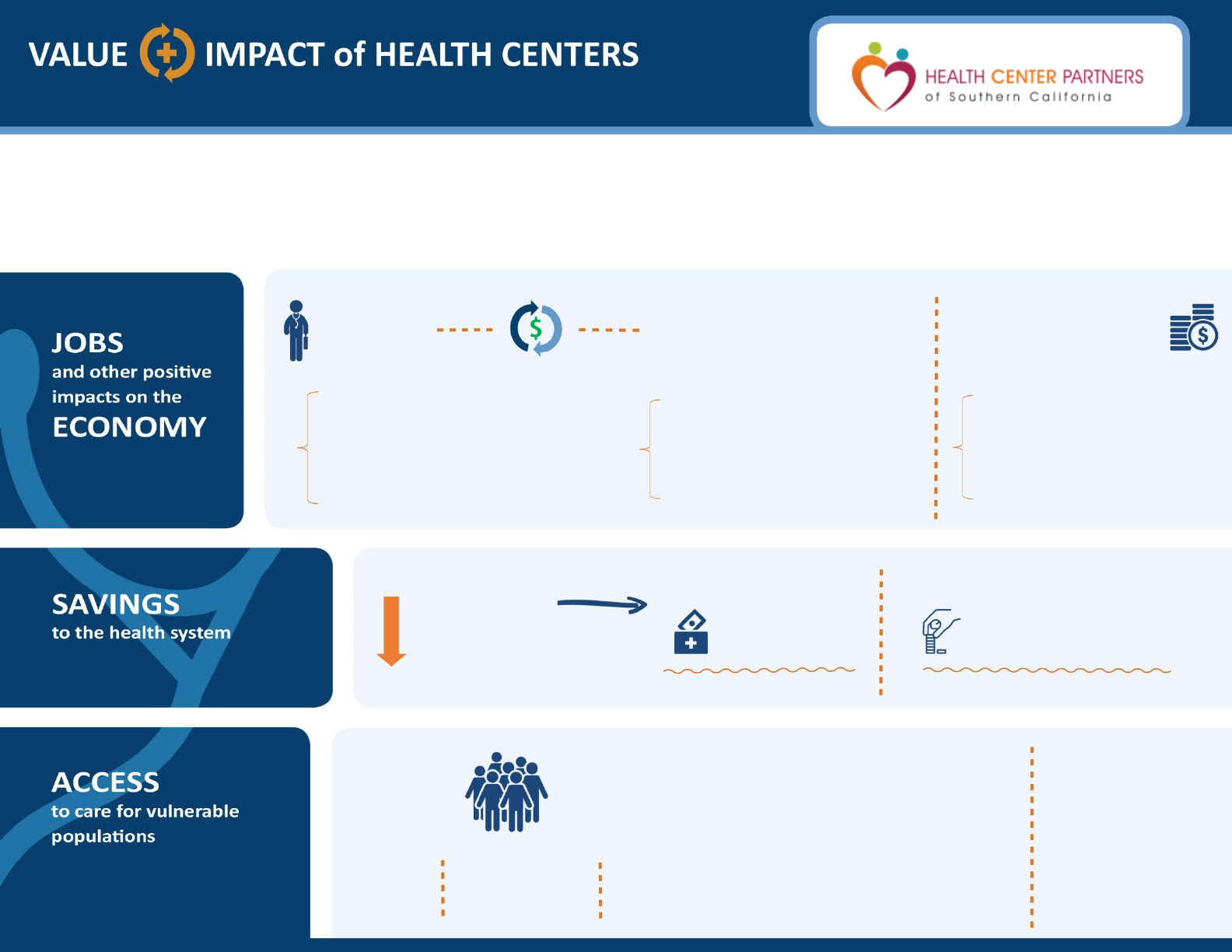
%
decline in
UNINSURED
PATIENTS
3,250,911
PATIENT
VISITS
Health Center Partners of Southern California
Seventeen Federally Qualified Health Centers (FQHCs) and other safety-net clinics provide care to residents of Southern California. They collectively provide
tremendous value and impacts to their communities—from ACCESS to care for vulnerable populations; SAVINGS to the health care system; JOBS and ECONOMIC
STIMULUS to local communities; STATE-OF-THE-ART, COMPREHENSIVE, COORDINATED CARE, with a focus on CHRONIC DISEASE MANAGEMENT and QUALITY
HEALTH OUTCOMES. Highlights of their
2017 contributions
are shown below.
Southern California Health Centers Provide...
11,412
$1,712,882,446
TOTAL ECONOMIC IMPACT
of current operations.
$281 Million
ANNUAL TAX REVENUES
$91 Million
STATE AND LOCAL TAX REVENUES
$190 Million
FEDERAL TAX REVENUES
TOTAL JOBS
6,226
HEALTH CENTER JOBS including
1,335 ENTRY-LEVEL and 2,756
SKILLED JOBS for community residents
5,186
OTHER JOBS IN THE COMMUNITY
$807,581,561
DIRECT HEALTH CENTER SPENDING
$905,300,885
COMMUNITY SPENDING
22%
LOWER COSTS FOR HEALTH
CENTER MEDI-CAL PATIENTS
$1.6 Billion
SAVINGS TO THE OVERALL
HEALTH SYSTEM
$1.2 Billion
SAVINGS TO
MEDI-CAL
806,158
PATIENTS
SERVED
6%
FOUR-YEAR
PATIENT GROWTH
234,033
patients are
CHILDREN AND
ADOLESCENTS
576,560
patients are
ADULTS
320,882
patients gained
INSURANCE
COVERAGE
94%
of patients are
LOW-INCOME
(Below 200% of the
Federal Poverty Level)
74%
of patients
identify as an
ETHNIC OR RACIAL
MINORITY
Since 2012
:
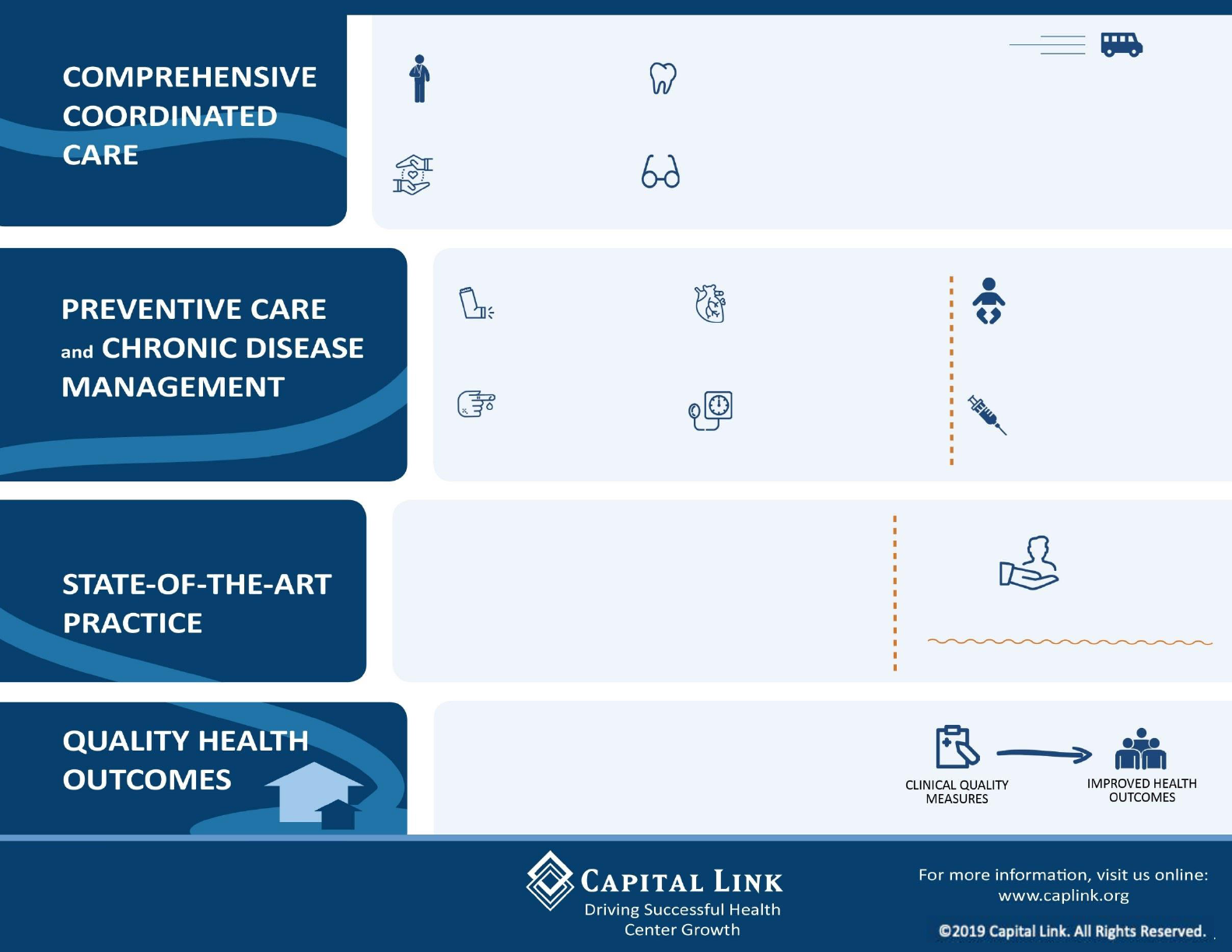
634,252
patients
received
MEDICAL CARE
38,691
patients received
MENTAL HEALTH CARE
234,403
patients
received
DENTAL CARE
17,920
patients
received
VISION CARE
79,091
patients received at least one
ENABLING SERVICE to overcome
barriers to care
In addition, patients received non-clinical
services to connect them to community
resources such as HOUSING, JOB TRAINING,
AND CHILD CARE
21,538
patients were
diagnosed with
ASTHMA
51,107
patients were
diagnosed with
DIABETES
12,416
patients were
diagnosed with
CORONARY ARTERY DISEASE
81,346
patients were
diagnosed with
HYPERTENSION
83,384
children received
WELL-CHILD VISITS
204,691
patients
received
IMMUNIZATIONS and
SEASONAL FLU VACCINES
76%
of centers recognized as
PATIENT-CENTERED MEDICAL HOMES
82%
of health centers have installed and currently use an
ELECTRONIC HEALTH RECORD (EHR)
76%
of health centers are currently participating in the
Centers for Medicare and Medicaid Services (CMS)
EHR INCENTIVE PROGRAM “MEANINGFUL USE”
100%
of health centers met or exceeded at least one
HEALTHY PEOPLE 2020 GOAL FOR CLINICAL
PERFORMANCE
Capital Link prepared this Value + Impact report using 2017
health center audited financial statements and Uniform Data
System information. Economic impact was measured using
2017 IMPLAN Online
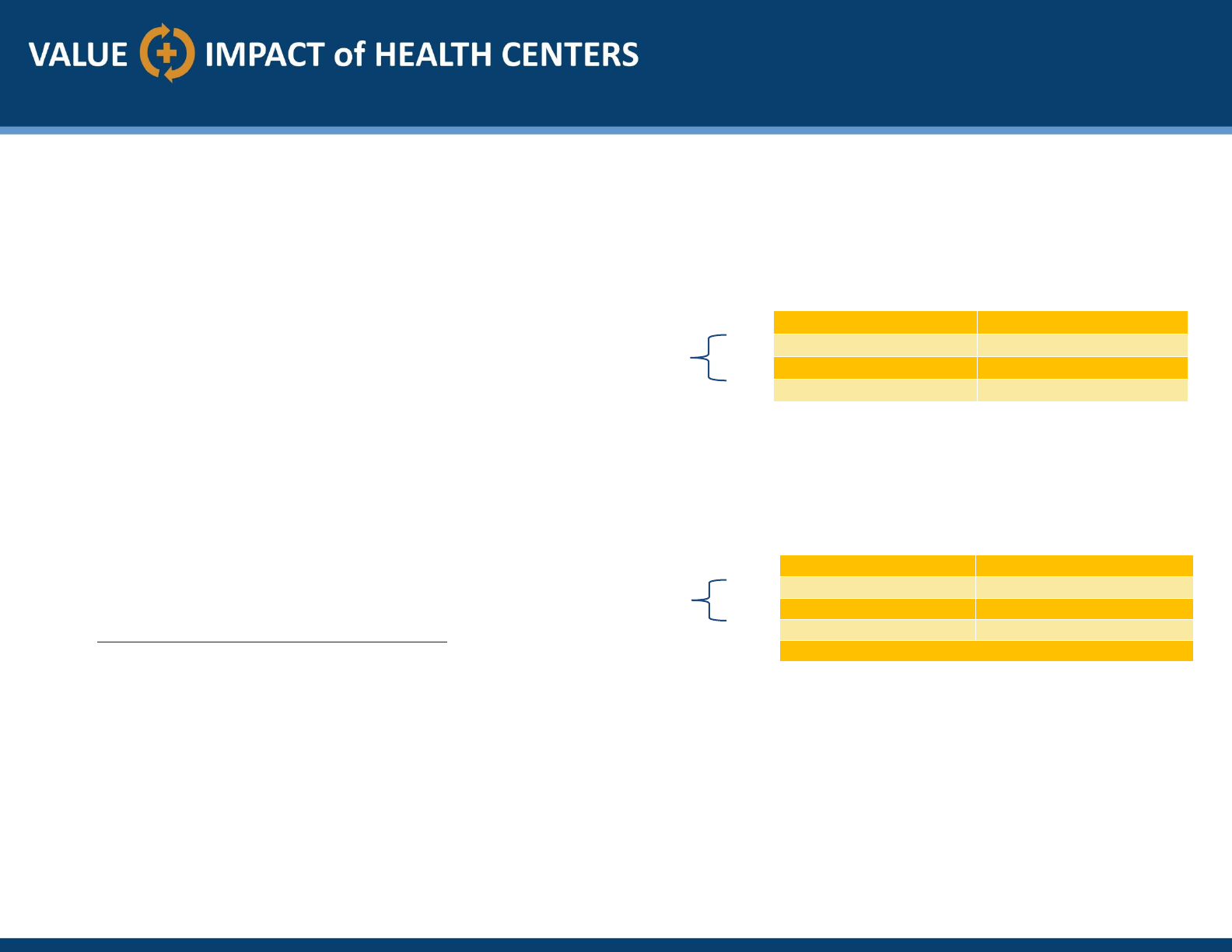
© 2019 Capital Link. All Rights Reserved.
Summary of 2017 Total Economic Activity
Stimulated by Current Operations of Seventeen
Economic Impact
Employment (# of FTEs
*
)
Direct
$ 807,581,561
6,226
Community
Impact
Indirect
$ 299,466,750
1,633
Induced
$ 605,834,135
3,553
Total
$1,712,882,446
11,412
Direct # of FTEs (employment) based on HRSA 2017 UDS state
level data for FQHCs.
Summary of 2017 Tax Revenue
Federal
State
Direct
$112,802,948
$33,988,290
Community
Impact
Indirect
$27,861,522
$15,125,030
Induced
$49,759,166
$41,633,202
Total
$190,423,636
$90,746,522
Total Tax Impact
$281,170,158
Health Center Partners of Southern California
REFERENCES AND DATA SOURCES
1. Access to Care for Vulnerable Populations: Bureau of Primary
Health Care, HRSA, DHHS, 2017 Uniform Data System.
2. Savings to Medi-Cal: Nocon et al. Health Care Use and
Spending for Medicaid Enrollees in Federally Qualified Health
Centers Versus Other Primary Care Settings. American
Journal of Public Health: November 2016, Vol. 106, No. 11, pp.
1981-1989.
3. Savings to the Health System: NACHC Fact Sheet: Health
Centers and Medicaid, December, 2016.
4. Economic and Employment Impacts: Calculated by Capital Link
using 2017 IMPLAN Online.
5. Comprehensive Coordinated Care: Bureau of Primary Health
Care, HRSA, DHHS, 2017 Uniform Data System.
6. Preventive Care and Chronic Disease Management: Bureau of
Primary Health Care, HRSA, DHHS, 2017 Uniform Data
System.
7. Quality Health Outcomes: Calculated by Capital Link based on
2017 Uniform Data System information and relevant Healthy
People 2020 targets found at
https://www.healthypeople.gov/2020/data-search.
*Full-Time Equivalent (FTE) of 1.0 means that the person is equivalent
to a full-time worker. In an organization that has a 40-hour work week,
a person who works 20 hours per week (i.e. 50 percent time) is reported
as “0.5 FTE.” FTE is also based on the number of months the employee
works. An employee who works full time for four months out of the year
would be reported as “0.33 FTE” (4 months/12 months).
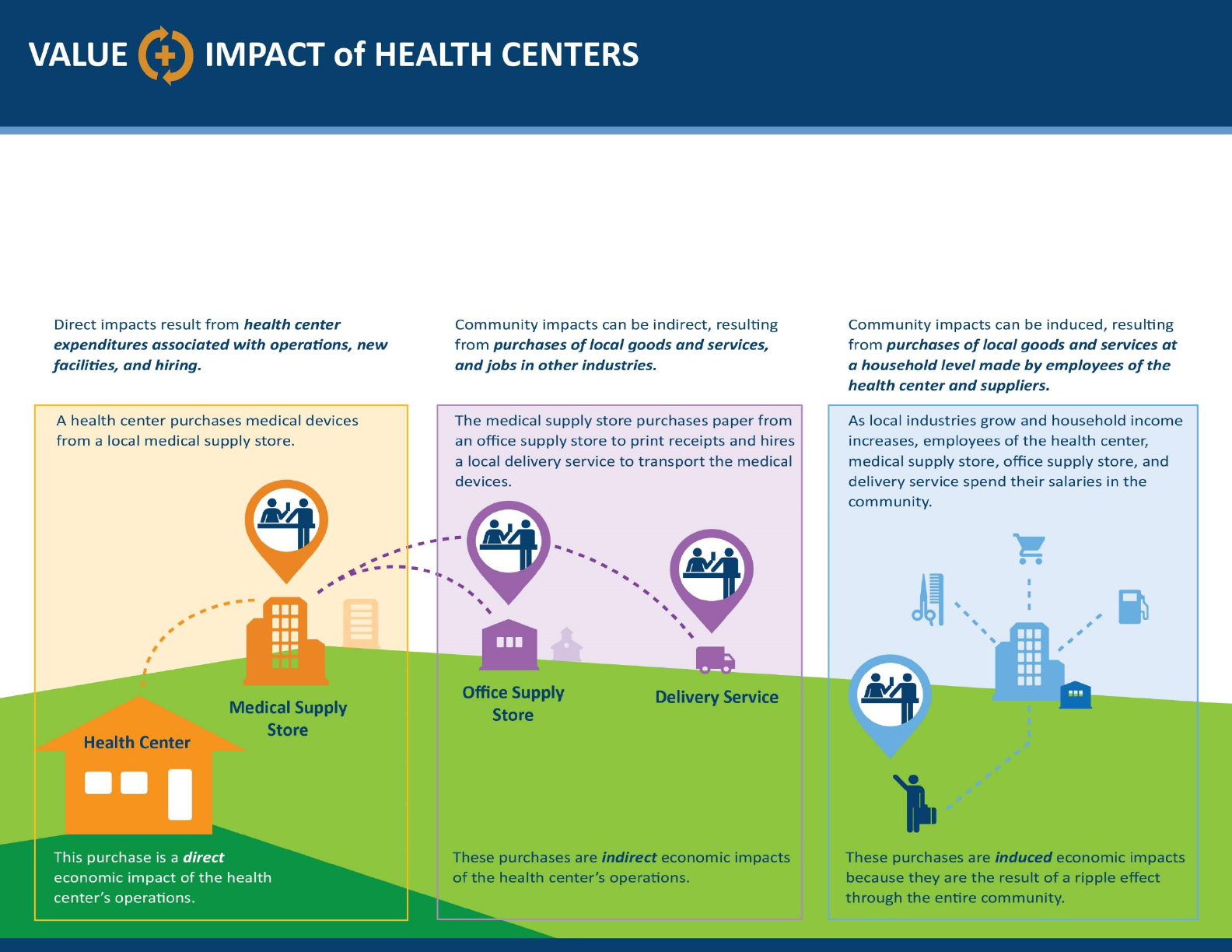
Health Center Partners of Southern California
HOW ECONOMIC IMPACT IS MEASURED
Using IMPLAN, integrated economic modeling software, this analysis applies the “multiplier effect” to capture the direct, indirect, and induced economic effects of health
center business operations and capital project plans. IMPLAN generates multipliers by geographic region and by industry combined with a county/state database. It is
widely used by economists, state and city planners, universities and others to estimate the impact of projects and expenditures on the local economy. This analysis was
conducted using 2017 IMPLAN Online.
WHAT ARE DIRECT AND COMMUNITY IMPACTS?
© 2019 Capital Link. All Rights Reserved.
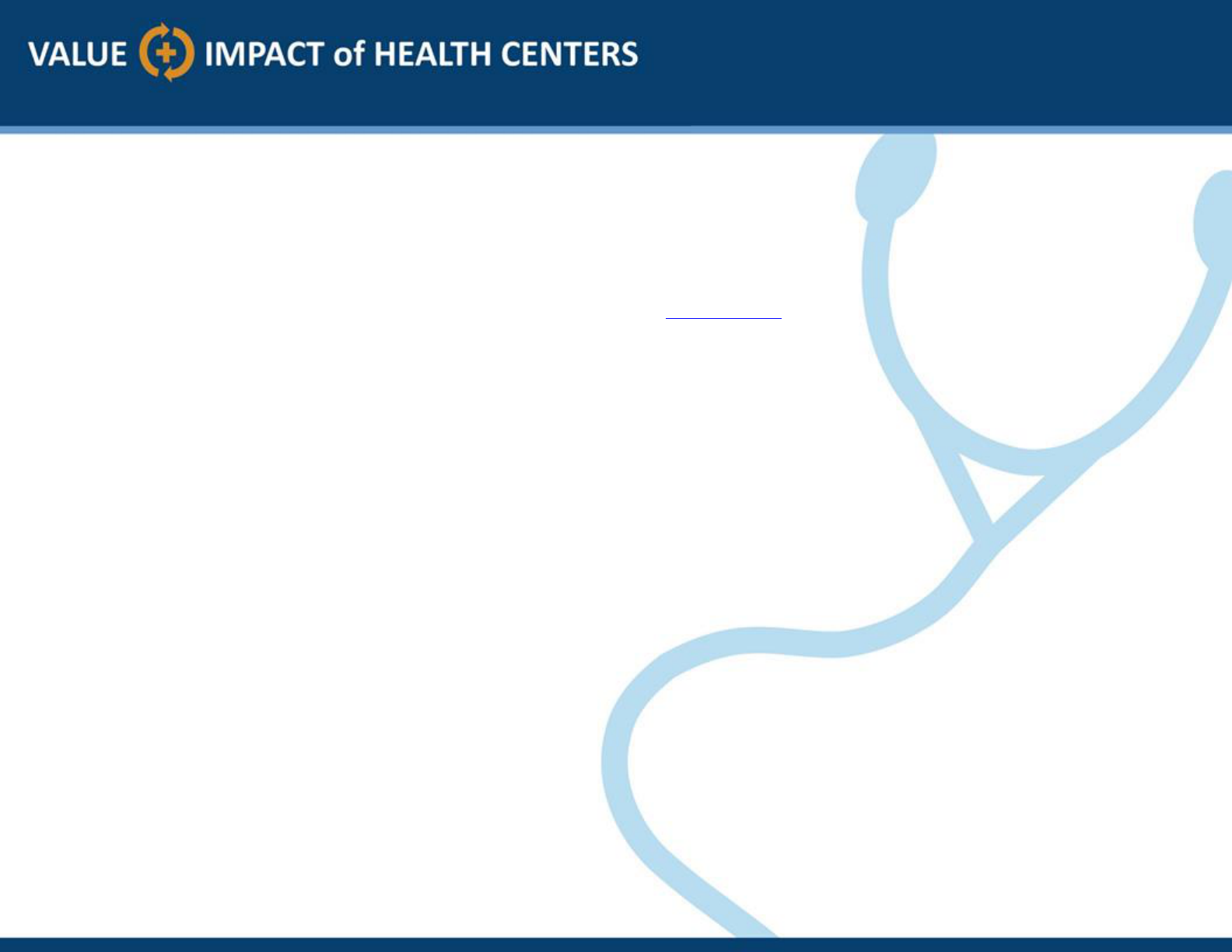
Health Center Partners of Southern California
© 2019 Capital Link. All Rights Reserved.
COMMUNITY HEALTH CENTERS INCLUDED IN THIS ANALYSIS
Borrego Health
Clinicas de Salud del Pueblo, Inc.
Community Health Systems, Inc.
Imperial Beach Community Clinic
Indian Health Council, Inc.
La Maestra Community Health Centers
Mountain Health
Neighborhood Healthcare
North County Health Services
Planned Parenthood of the Pacific Southwest
Samahan Health Centers
San Diego American Indian Health Center
San Diego Family Care
San Ysidro Health
Southern Indian Health Council, Inc.
St Vincent de Paul Village
Vista Community Clinic
This report was developed by Capital Link, a non-profit organization that
has worked with hundreds of health centers and Primary Care Associations
for over 18 years to plan capital projects, finance growth, and identify ways
to improve performance. We provide innovative consulting services and
extensive technical assistance with the goal of supporting and expanding
community-based health care. For more information, visit us online at
www.caplink.org.
